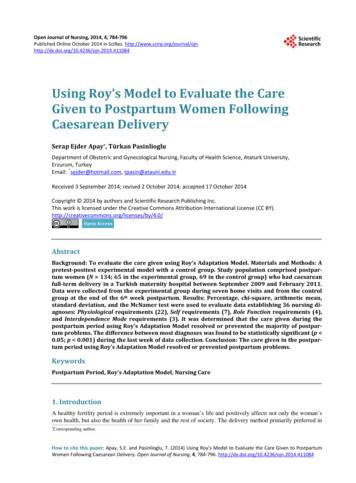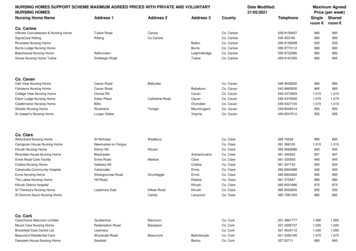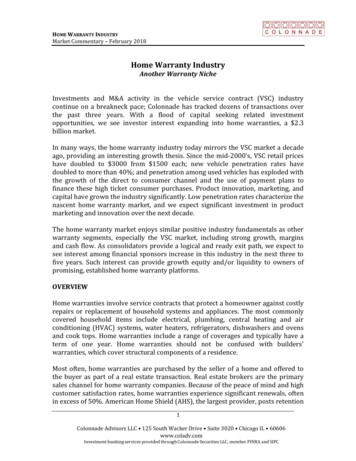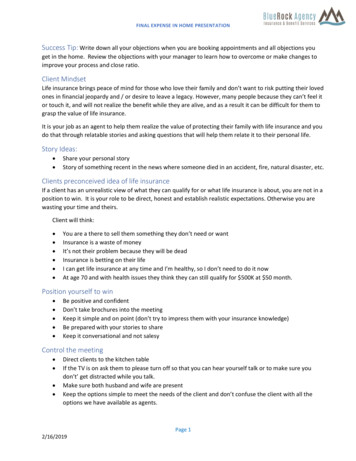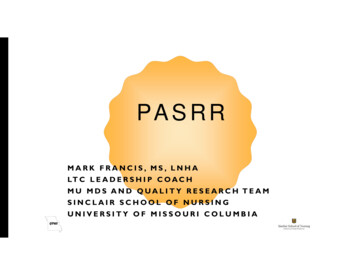
Transcription
PA SRRMARK FRANCIS, MS, LNHALT C L E A D E R S H I P C O A C HMU MDS AND QUALITY RESEARCH TEAMSINCLAIR SCHOOL OF NURSINGUNIVERSITY OF MISSOURI COLUMBIA
PASRR H ISTORY AND O VERVIEWIn 1840 Dorothea Dix activist, lobbied for betterliving conditions for the mentally ill and created theinstitutional care model.
PASRR H ISTORY AND O VERVIEW By the mid-1950s, a push for deinstitutionalization andoutpatient treatment began in many countries, facilitated bythe development of a variety of antipsychotic drugs. 1970s and 1980s, states moved individuals with mentalillness out of state-funded institutions (including psychiatrichospitals) and into the community. Housing was not always available so individuals wereadmitted to nursing homes, as default housing.
PASRR H ISTORY AND O VERVIEW In 1987 Congress enacted legislation directed tolong-term care facilities. The primary goal of this law, known as the NursingHome Reform Act, was to establish uniformstandards for nursing homes and ensure theprotection and safety of patients.
PASRR H ISTORY AND O VERVIEW Nursing homes participating in Medicare andMedicaid were required to “provide servicesand activities to attain or maintain the highestpracticable physical, mental, and psychosocialwell-being of each resident in accordance witha written plan of care”. The Nursing Home Reform Act alsoestablished a bill of rights for nursing homeresidents.
PASRR H ISTORY AND O VERVIEWTherighttolive in a caring environment free from abuse, mistreatment and neglectTherighttolive without the fear of enduring physical restraintTherighttoprivacyTherighttoreceive personal care that accommodates physical, medical, emotional, social needsTherighttoa social contact/interaction with fellow residents and family membersTherighttobe treated with dignityTherighttoexercise self-determinationTherighttoexercise freedom of speech and communicate freelyTherighttoparticipate in the creation and review of one’s individualized care planTherighttobe fully informed in advance of changes to care plan or status of the nursing homeTherighttovoice grievances without discrimination or reprisal
PASRR H ISTORY AND O VERVIEWOBRA 1987 did not include a mandated process forStates to implement for PASRR.The 1990 and 1992 regulations also granted statesenormous flexibility in implementing PASRR.
PASRR H ISTORY AND O VERVIEW On September 28, 2016, the Centers for Medicare & MedicaidServices (CMS) issued updated federal nursing home regulations.This was the first comprehensive revision to the regulations sincethey were issued in 1991 despite significant changes in the industry. The updated rule (also referred to as the “final rule”) wasimplemented in three phases: Phase 1- November 28, 2016; Phase 2- November 28, 2017; and Phase 3 - November 28, 2019.
PASRR H ISTORY AND O VERVIEW The new rules were designed to meet the needs of abroader resident population with a wide variety ofdiagnosis and a wider age range and ensure that theregulatory environment stays relevant to the populationseen in nursing facility. The requirements require integration of the PASRRassessment into the NF plan of care and new requirementsrelated to the behavioral health needs of individuals.
PASRR H ISTORY AND O VERVIEW Protect individuals with serious mental illness (SMI) orintellectual disability (ID) or a related condition frominappropriate placement in nursing facilities. Ensure that individuals receive all specialized servicesnecessary to meet the individual's unique MI/ID needs ifadmitted to a NF. Provide the opportunity to identify alternativecommunity supports.
N URSING F ACILITY L EVEL OF C AREThe Department of Health and Senior Services (DHSS) utilizesthe Initial Assessment-Social and Medical forms (DA124 A/B) toinitiate the process for admission to a Nursing Facility. DHSSdetermines the need for nursing facility services throughestablished NF level of care criteria (24 points). The Medicaidlevel of care criteria can be found in DHSS regulation 19 CSR30-81.030 PDF Document. A special admission category mustbe granted/approved by DHSS to admit an individual to a SNFbefore a PASRR assessment is completed.
PASRR H ISTORY AND O VERVIEWPASRR has tw o core components:1) The Level I screen (DA 124C) given to all NFapplicants is reviewed by DHSS Central Office MedicalReview Unit (COMRU) after completion of the LOC.The Level 1 is also used for a significant change ofcondition.2) The Department of Mental Health is responsible forthe Level II evaluation. DMH contracts with BockAssociates to complete the evaluations.
PASRR H ISTORY AND O VERVIEWThe Level I screen must: Capture all persons with suspected or known SMI, ID, orRC/DD. Be sensitive (identify everybody it was meant to identify). Be specific (include few people who did not need to betargeted).
PASRR H ISTORY AND O VERVIEWIndividuals are referred to DMH for Level II Evaluations bythe DHSS Level I screener/State Medical Consultants.The purpose of the PASRR Level II Evaluation is tocomprehensively assess individuals who are known to haveSMI, ID, or a RC, or who met the federal criteria forsuspicion and could be affected by those conditions.
PASRR H ISTORY AND O VERVIEWThe Level II evaluation examines the diagnosis ofrecord to confirm or disconfirm a positive Level I todetermine whether placement or continued stay inthe requested or current NF is appropriate; and tocalculate the MI/ID services the individual needs. TheLevel II Evaluation is the basis for determining theindividual's needs for care and/or specialized services(SS).
PASRR H ISTORY AND O VERVIEWDMH contracts with Bock Associates for completion ofthe Level II evaluations for both ID/MI.The Bock Assessors determine the least restrictive andmost appropriate setting in which an individual’s needsmay be supported.PASRR can assist states to meet obligations under theAmericans with Disabilities Act (ADA) and the SupremeCourt's Olmstead decision.
PASRR, ADAANDO LMSTEADThe Department of Health and Human Services(HHS) is increasingly holding states accountable tocomply with the Olmstead Supreme Court decision.Under the ADA, individuals with disabilities cannot berequired to be institutionalized to receive publicbenefits that could be furnished in community-basedsettings.
PASRR H ISTORY AND O VERVIEWPASRR determinations must consider communityservices first, and recommend institutional placementonly when appropriate.
PASRR D ETERMINATIONSThe State Mental Health or Intellectual DisabilityAuthority (SMH/IDA) must make two determinations: Whether nursing facility services are appropriate andneeded Whether specialized services are needed
PASRR T IME F RAMESPASRR determinations must be made in writingwithin an annual average of 7 to 9 working daysfrom the date a positive Level I screen isidentified of referral. PASRR ends withnotification of the determination.
A PPEALSAny and all negative determinations can be appealed.No person is denied a determination that NFservices are needed when a preferred placement isunavailable.
S UMMARY PASRR is to identify appropriate placement and services (Newadmissions and existing residents.) NF application includes PASRR for individuals with ID MI or arelated condition. NF eligibility includes a Level of Care (LOC). PASRR consists of two components and an appeal process. PASRR is a tool that states can use to meet Olmstead obligations.
R ESOURCES CMS PASRR Technical Assistance Center www.pasrrassist.orgThis Photo by Unknown Author is licensed under CC BY-SA
N ATIONAL A SSOCIATION OF PASRRP ROFESSIONALS (NAPP)NAPP is a non-profit educational organizationdedicated to advancing the profession of individualsand organizations working in the federally mandated:Pre-Admission Screening and Resident Review(PASRR) Programwww.pasrr.org
INS AND OUTSO F T H E D A 1 24DEBBIE POOL, BSN,RN,LNHAC L I N I C A L E D U C AT O RMU MDS AND QUALITY RESEARCH TEAMSINCLAIR SCHOOL OF NURSINGUNIVERSITY OF MISSOURI COLUMBIA
W HO R EQUIRES A DA-124C A PPLICATIONANY RESIDENT ADMITTEDTO A MEDICAIDCERTIFIED BED MUSTCOMPLETE A DA124 C(LEVEL 1) APPLICATIONTHIS INCLUDES DUALLYCERTIFIED BEDS, BOTHMEDICARE ANDMEDICAID
DA-124C L EVEL 1 A PPLICATION For a person’s first admission to a nursing facility; If the person has been out of a nursing facility 60 days or greater; If Family Support Division (FSD) requests re-applying for Medicaid(indicate re-applying for Medicaid on the DA-124 A/B); If the resident (with MI or MR) has had a Significant Change in Statusper the MDS 3.0, indicate the Change of Status on the DA-124 A/B.
L EVEL II R EVIEW T RIGGERSThe DA-124 application will assist in identifying a resident that requires a Level II screening. The DA-124Cform must be completed prior to admitting the resident to a SNF to ensure the resident doesn’t trigger aLevel II screening. A Level II screening refers to a resident with a diagnosis of Mental Illness or MentalRetardation. **Note: A resident that requires a Level II screen can not be admitted to a SNF prior tothe determination of the Level II.Triggers: Anyone admitted to a Medicaid certified bed meeting one of the following criteria:1) Has had inpatient psychiatric treatment in the past 2 years; should have a Major Mental Illness diagnosis.2) Indication of being dangerous to self and others; serious behavioral problems; suicidal or homicidal, even if Dementiais the primary psych diagnosis;3) Legal Issues; incarceration or history of, charges of assault, murder, sex offence; etc.4) Has a diagnosis of Intellectual Disability (diagnosed before age 18);5) Has a Developmental Disability (DD) condition related to Intellectual Disability (onset before age 22). Examples: TBI,Cerebral Palsy, seizure disorder, etc.
DA-124C N EXT S TEP If the resident does not trigger a Level II screening and is not applying forMedicaid, the DA-124C is placed in the resident’s medical record until theresident requires a Level II screening and/or applies for Medicaid reimbursement. If a Medicaid certified bed is requested and the resident has a diagnosis of MentalIllness(MI) or Mental Retardation (MR)/developmental disability, the State ofMissouri mandates a DA-124 A/B and C application be submitted to COMRU. The COMRU unit will review (a) level of care points (State Regulation) and (b)whether a Level II screening by DMH is required (Federal Regulation). This shouldbe done prior to nursing facility admission unless a valid special admissioncategory is determined.
Scan and send by encrypted email toCOMRU@health.mo.govOvernight m ailDHSS/COMRU3418 Knipp Drive, Suite FJefferson City, MO 65109Regular M ailDHSS/COMRUPO Box 570Jefferson City, MO 65102SUBMITTINGYO U RA P P L I C AT I O NIf the application isemailed, DO NOTsend the applicationvia mail. Do notfax the applicationunless instructed.
DA -124CSection AIdentifying Information/ResidentDemographicsSubmitting facility withcontact information
DA -124CGuidance
S ECTION B. L EVEL O NE S CREENING C RITERIA FORS ERIOUS M ENTAL I LLNESS
S ECTION C. L EVEL O NE S CREENING C RITERIA FORM ENTAL R ETARDATION OR R ELATED C ONDITION
S ECTION D. S PECIAL A DMISSION C ATEGORIES( TO BE U SED O NLY W HEN L EVEL II S CREENING I NDICATED )
SPECIALADMISSIONCAT E G O RY( SAC )Used only when theapplication triggers theLevel IIMust be validated byCOMRUTime specific, facility isresponsible for notifyingCOMRU of discharge or tostart the Level II process
S ACREFERRALSHEETSection D of DA-124Cshould correspond tothe SAC Referral Sheet.It is the admittingfacility’s responsibilityto ensure completionand accuracy.
The applicant may enter the Skilled NursingFacility (SNF) prior to completion of a Level IIPASRR evaluation or Special Admission Category. The Hospital (or other individual completing thepaperwork) will send the completed DA 124 Cform to the SNF prior to discharge. The SNFshould review the client’s information to ensurethe Level of Care points (24) would meet prior toadmission and ensure they have enoughinformation to determine if they can meet themedical and behavioral needs of the individual. The SNF will submit the entire DA 124 application(DA 124 A/B, DA 124 C and any other supportingdocumentation) with a Special AdmissionCategory form indicating “Waiver due to COVID19” to COMRU@health.mo.gov1 1 3 5 WA I V E REffective April 2, 2020 andthrough the end of the FederalEmergency Declaration,certified Skilled NursingFacilities and IntermediateCare Facilities may follow theprocess outlined below fornew admissions into Medicaidcertified beds.For an applicant that mayrequire a Level II evaluation(have a qualifying mental illness(MI) or intellectual disability(ID) diagnosis)
The SNF should indicate if the client plans toreside at the SNF after 30 days. DHSS recommends that SNFs submit thecomplete DA 124 application to COMRU within14 days of admission to the SNF. Once received, COMRU will determine if theapplicant meets Level of Care and refer applicantsrequiring a Level II PASRR screening to DMH. After 30 days, new admissions with mental illness(MI) or intellectual disability (ID) will receive aResident Review as soon as resources becomeavailable.1 1 3 5 WA I V E R
The applicant may enter the Skilled NursingFacility (SNF) prior to completion of a Level IIPASRR evaluation or Special Admission Category. COMRU will process all pending Level II PASRRapplications as Special Admission Category #5indicating “Waiver due to COVID -19”.1 1 3 5 WA I V E RFor completed applicationsalready submitted toCOMRU for processing. Upon discharge, the hospital or other submitterwill notify COMRU via email of the followinginformation: the client’s name, DCN or SSN#, andthe receiving SNF information (Name, Telephonenumber and fax number).This information should beadded to the DA 124 applicationin process and sent to DMH.For the DA 124 applications thatwere already referred for Level IIPASRR screening, The hospital/submitter will ensure a copy of theDA 124 application (DA 124 A/B form and DA 124C form) are sent to the accepting SNF prior todischarge.DHSS will notify DMH and Bock& Associates via email of theindividuals change in location.
S E C T I O N F.PHYSICIANAU T H O R I Z AT I O N/ S I G NAT U R EPhysician discipline, licensenumber and date ofsignature required.Print physician’s full nameunder signature.NP/PA CANNOT sign theform.
DA - 12 4 A / BSection A. Socialassessment.Residentdemographics.Contact person.Guidance forcompletion on reverseside.
DA - 12 4 A / BGuidance
SECTION B.MEDICALASSESSMENT#6. Recent medical events:surgery, CVA, fracture, headinjury with dates.#8. Prescription meds: dosageand frequency, mustcorrespond to a medicaldiagnosis. Must be on the DA124 application or MAR.Include on a second page isnecessary.#15 Indicate if able tonegotiate pathway to safety.
SECTION B.#16.ASSESSEDNEEDSPoints are assigned for the amountof assistance required, complexityof care and the professional levelof assistance necessary, based onthe level of care criteria.The resident is assessed and ifdetermined to have a point level of24 or more can be admitted to theSNF.Points come from mobility, dietary,restorative services, monitoring,medications, behaviors, treatments,personal care and rehab services.
S ECTION B #16 A SSESSED N EEDS Include frequency of services Clinical information should correspond to and not contradict with #13mental, #14 Behavioral information and #15 Functional impairments The Assessed Needs must descriptive for the resident Identify how much nursing care the resident requires No points are assigned for blank areas Explain exactly what staff are doing:– resident requires physical therapy 5x weekly– resident needs assistance with dressing and is incontinent
S INGLE N URSING S ERVICE R EQUIREMENTS
A PPLICATION S UBMISSION Level of Care (LOC) is completed by paper review. Review application prior to submitting to COMRU to ensure all areascomplete with inclusion of all relevant information to resident care. Facility to make any corrections and resubmit the application. Allow COMRU 10 working days, from the date received in the COMRU office,to complete the application and release to Family Support Division. Include fax number and/or email address on the DA-124 application for anycorrespondence to be sent to the facility or hospital from COMRU.
W HEN NOTTOS UBMIT A DA-124 A PPLICATION If the resident is receiving vendor payment and is a direct admit from one SNFto another SNF. The application, approval letter, and PASRR Level II screening (if applicable)must be obtained from the prior SNF for the current medical record. Failure to obtain a previous PASRR report could result in a citation from DHSSsurveyors. Review the PASRR Level II screen (if applicable) to ensure appropriate itemsare included on the admission/baseline care plan.
C HANGE IN S TATUS ( PER MDS 3.0) The resident must be previously approved for SNF in order for this application to be a Changein Status. The resident must have been approved for SNF placement and has not been out ofthe SNF for greater than 60 days. A Significant Change in Status is defined as a change in 2 or more areas on the MDS3.0 regarding a resident’s needs. It can either be a decline or improvement and can be aphysical or mental change.– Refer to RAI manual Chapter 2 pgs. 22-29 for SCSA requirements. Submit a DA-124 A/B and C application for a Change in Status on residents that have adiagnosis of MI or MR ( not all residents). The facility should write “Change in Status” on the top of the DA-124A/B and C.
C HANGE IN S TATUS The facility should provide an explanation (attach a short summary) as to whythe resident triggered a Significant Change in Status (what were the triggers onthe MDS 3.0). A resident does not have to be admitted to the hospital to trigger a Change inStatus. If the MDS 3.0 triggers a change in status on a resident with MI or ID, thefacility would need to complete and submit the DA-124 application for review.
C HANGE IN S TATUS F LOWSHEET
S CENARIOS
R ESOURCES www.health.mo.gov/seniors/nursinghomes/pasrr.php COMRU homepage for DA-124 A/B & Capplications, instructions, PDF documents www.COMRU@health.mo.gov CMS RAI 3.0 Manual Chapter 2 Assessments for RAI 03 Significant Change in StatusAssessments A0310A-04, pages 22-29 PASRR: Readmission Screening and Resident Review Crystal Plank, BSN, RN, RAC-CT QIPMOClinical Educator www.cms.gov F644 Coordination of PASRR Assessments, F645 PASRR Screening for MD/ID,Critical Element Pathway Form CMS-20090 (5/2017)
Behavioral Health Services inLong Term CareTracy Niekamp, Assistant AdministratorSection for Long‐Term Care Regulation
The BasicsFirst Step‐ Level of Care Assessment and 19 CSR 30‐81.030(5)(G)(6) As part of the level of care assessment of behavioral needs, COMRU reviews if the applicantexhibits uncontrolled behavior that is dangerous to themselves or others. Individuals may be admitted who require maximum behavioral assistance in the form ofextensive supervision due to psychological, developmental disabilities or traumatic braininjuries with resultant confusion, incompetency, hyperactivity, hostility, severe depression, orother behavioral characteristics. This category includes residents who frequently exhibitbizarre behavior, are verbally or physically abusive, or both, or are incapable of self‐direction. By state regulations, applicants who exhibit uncontrolled behavior that is dangerous tothemselves or others “must be transferred immediately to an appropriate facility”.
The BasicsSecond Step‐ Pre‐Admission Screening and Resident Review (PASRR) As part of the level of care process, COMRU reviews applicants to determine if they havediagnoses that include a mental disorder and/or an intel
(pasrr) program www.pasrr.org. ins and outs of the da124 debbie pool, bsn,rn,lnha clinical educator mu mds and quality research team sinclair school of nursing




